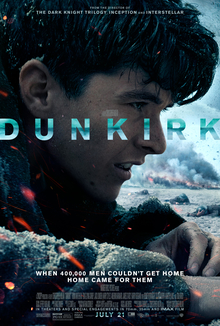
Producers: Emma Thomas
Christopher Nolan
Writer: Christopher Nolan
Starring: Fionn Whitehead
Tom Glynn-Carney
Jack Lowden
Harry Styles
Aneurin Barnard
James D’Arcy
Barry Keoghan
Kenneth Branagh
Cillian Murphy
Mark Rylance
Tom Hardy
Music By: Hans Zimmer
Cinematographer: Hoyte van Hoytema
Editor: Lee Smith
Dunkirk, the latest film by Christopher Nolan, recounts the real-life Dunkirk evacuation of WWII, where over 300,000 men were evacuated by hundreds of boats from the beaches of Dunkirk in the aftermath of a disastrous battle between allied forces and the Nazis. To many people, the Dunkirk evacuation was a miracle. Coincidentally, this film happens to be miraculous too.
Dunkirk is not a long film, in fact it only runs at a mere 106 minutes, but that gives Nolan plenty of time to drive a powerful piece of cinema into our minds and hearts. Opting for less dialogue and more of a reliance on music and intense sound, the film follows a slightly nonlinear narrative focusing on several groups of people. We first meet Tommy (Fionn Whitehead), a young British soldier who is attempting to flee Dunkirk with a French soldier named Gibson (Aneurin Barnard). Then there is Mr. Dawson (Mark Rylance), a sailor who takes his own ship to aid in evacuations along with his son, Peter (Tom Glynn-Carney), and his son’s friend, George (Barry Keoghan). Lastly, there is Pilot Office Collins (Jack Lowden) and fellow pilot Farrier (Tom Hardy) who are supporting the troops through the air. There are also some other roles played by Harry Styles, Kenneth Branagh, and Cillian Murphy.
The acting in Dunkirk is phenomenal and I cannot give the ensemble cast enough praise. The actors demonstrate such raw emotion that it’s impossible to not relate to them. Murphy’s performance as unnamed soldier, believably highlights fear and angst that makes his relatively small role larger than life and is a perfect representation of the rest of the cast’s tenacity and dedication to their roles.
Perhaps the biggest star is nobody in the cast, but director Nolan himself. In the vein of Kubrick’s 2001: A Space Odyssey, Nolan allows silence and music by Hanz Zimmer to build tension throughout the film. When there is dialogue, it’s brief, and the audience is left with a heart-pounding score and the occasional deafening gunfire that puts them right in the battle. There is also a great deal of crisp camera work that allows the audience to experience a mixed bag of feelings that includes tunnel vision, claustrophobia, and the sense of unbelievable scope.
As I mentioned previously, the film features a nonlinear narrative, and Nolan uses an interesting way of allowing audiences to piece it together. Early in the film, Farrier’s fuel gauge is damaged in a dogfight and by using his communications with Collins, he is able to chart how much fuel he has remaining by marking it with a piece of chalk. It begins with fifty gallons and then the amount varies as the film progresses, whether it drops to fifteen or rises back to fifty. This allows an extra layer of complexity to the film and it introduces a bit of audience interaction that other films lack.
Cinematographer Hoyte van Hoytema also deserves praise for the beautiful shots of the beach and turquoise sea that are scattered throughout the film. There are several scenes featuring huge layers of beach foam blowing in the wind that strikes a chill down the audience’s spine, because it allows them to feel just how cold Dunkirk really is. The combination of Nolan and Hoytema allow the audience to simultaneously feel the bitter cold and beauty that is presented on screen.
It’s clear that Dunkirk is a film that is striving for something greater and attempting to break free of genre convictions. It features raw emotion, beautiful shots, and of course, a tension that increases throughout. With beautiful cinematography, rich sounds, and an exquisite cast, Dunkirk is perhaps Nolan’s masterpiece and one of the most inventive and bold war films to date.
